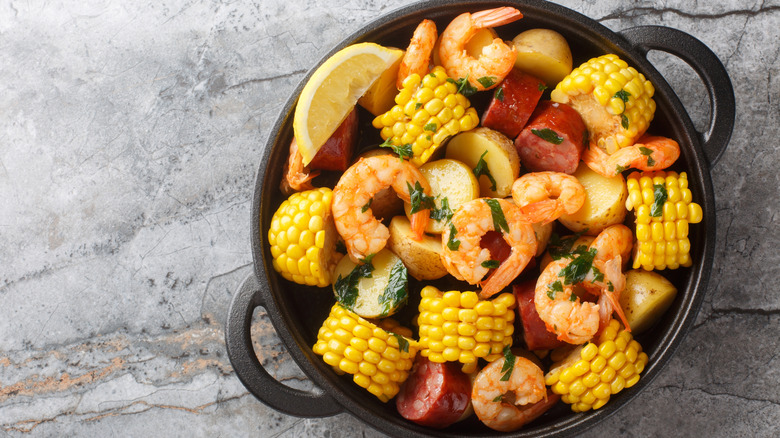The Aluminum Foil Hack For A Quicker, Easier Seafood Boil
Few things hit the spot like a seafood boil. This labor of love comes together in a family-style spread of seafood, often paired with potatoes, corn, sausage, and even eggs, all simmered together in a well-seasoned broth — or at Red Lobster if you're short on time. The final result is a hearty, flavor-packed feast meant to be shared and enjoyed with good company.
Whether it's a Louisiana-style boil or a classic lowcountry version, a seafood boil is surprisingly simple for a home cook to master, and with just a little bit of aluminum foil, you can make the whole cooking process even easier while still locking in bold, delicious flavors. To learn more, Food Republic spoke exclusively with Anthony Spizale, Sodexo executive chef at Nicholls State University. According to Spizale, when cooking your seafood boil ingredients in a foil packet instead of using the traditional-pot method, "seafood and veggies steam in their own juices with bold spices like Bayou spice, garlic, and herbs, creating concentrated, punchy flavors. Proteins stay juicy, vegetables retain a firm bite."
Cooked over an oven or grill, this time-saving, mess-reducing method works because the aluminum foil creates a sealed, steamy environment that traps the natural juices, turning them into a flavorful steam concentrated with smoky Southern-style spices. This differs from a traditional large-pot method, where "ingredients share their flavors in the boil liquid; [giving] softer textures and more subtle, blended seasoning," says Spizale. In the large pot of seasoned liquid, the flavors of the ingredients mingle and balance out rather than staying concentrated.
The differences between a traditional and foil packet boil
When choosing between doing a seafood boil the traditional or foil-boil way, you're simply deciding between steaming and boiling, and each has different requirements. In a traditional boil, you add your ingredients to a rolling boil in order of cooking time. For the foil-boil method, this simply isn't possible. To prevent under-cooked ingredients, longer-cooking ingredients like "small potatoes or corn may need par-cooking," chef Spizale shares.
Taking this into account, there are some ingredients which should generally be avoided when using the foil-boil method, which include "large potatoes (unless par-boiled), crab legs without pre-steaming, [and] delicate greens," Spizale tells us. While these ingredients are delicious when boiled, they can quickly suffer in both the texture and flavor department when steamed. Ingredients that work best in a foil-boil are easy-steamed ingredients such as "shrimp, white fish, small potatoes, corn, smoked sausage, lemon slices, tomatoes, and aromatic herbs," he adds.
With the more delicate foil steaming process, you need to layer your ingredients intentionally. For the base layer, Spizale recommends "par-cooked potatoes and corn tossed with a touch of avocado oil and creole spice," followed by your protein and seasonings, then "fold foil to trap steam; [then] cook on a sheet tray in the oven or over a grill." This will ensure that everything cooks evenly, all while locking in those bold, concentrated flavors. When using the foil-boil method, "don't overfill [and] leave space for steam." If the packet is overcrowded, the steam won't circulate evenly and may not properly seal, causing the ingredients to not cook evenly.


